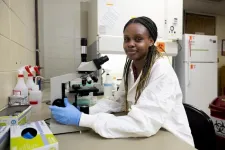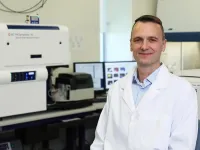(Press-News.org) UNIVERSITY PARK, Pa. — Biodegradable electronics allow for medical devices — such as drug delivery systems, pacemakers or neural implants — to safely degrade into materials that are absorbed by the body after they are no longer needed. But if the water-soluble devices degrade too quickly, they cannot accomplish their purpose. Now, researchers have developed the ability to control the dissolve rate of these biodegradable electronics by experimenting with dissolvable elements, like inorganic fillers and polymers, that encapsulate the device.
The team, led by Huanyu “Larry” Cheng, the James L. Henderson, Jr. Memorial Associate Professor of Engineering Science and Mechanics at Penn State, published their findings in Advanced Functional Materials.
“Biodegradable electronics enable patients to have one surgery instead of two, as they do not need to undergo a second operation to remove the implant once it is in place, but we still need the device to last long enough to accomplish its medical purpose,” said Ankan Dutta, co-first author on the paper, doctoral student in engineering science and mechanics and fellow of the Cross Disciplinary Neural Engineering Training Program at Penn State. “In this work, we developed an encapsulation strategy that allows a device to remain in the body without degrading for over 40 days while retaining its mechanical properties, which surpasses previously reported devices.”
Encapsulating a biodegradable device using zinc oxide- or silicon dioxide-based fillers allow the device to break down slower, and therefore work for longer periods of time, Dutta explained.
Dutta used modeling software to determine how using different materials and designs impacted the onset of degradation of the electronic implant in the body. He and the team found that coating the device in silicon dioxide flakes worked best to control the degradation rate.
Through modeling, Dutta also determined how the ratio of the width and thickness of the encapsulation, or aspect ratio, played a role in predicting the degradation onset of the device.
“Inexpensively, we can fine tune how fast a device will degrade based on the aspect ratio, the types of materials used and how many fillers were used,” Dutta said. “We are achieving what we call ‘on demand transient electronics,’ where we passively control how fast an implant degrades inside a body based on its materials.”
Collaborators at Korea University (KU), led by co-corresponding author Suk-Won Hwang, associate professor in the KU-Korea Institute for Science and Technology (KIST) Graduate School of Converging Science & Technology, used Dutta’s simulations to fabricate a prototype of a biodegradable implant.
“A high-efficiency biodegradable encapsulation approach can significantly increase the functional lifetime of electronic devices, which consist of a biodegradable polymer matrix and a biodegradable organic filler, to create a dispersed composite solution,” Hwang said. “The composite solution was cast into a film, allowing for large-scale production without additional treatments, enhancing its practical applicability.”
In past research, which Dutta outlined in a review paper he co-authored with Cheng and published in Nanoscale in 2023, the researchers explored active degradation of implants. In active degradation, researchers use third-party systems like ultrasound or light technology to trigger a device to break down from outside of the body — however, they found that the practice can be costly and difficult in clinical settings.
“Devices that passively degrade on their own without the use of third-party systems are both inexpensive and more feasible to potentially use in a patient care setting in the future,” Dutta said.
In addition to Cheng, Dutta and Hwang, other contributors include Gwan-Jin Ko, Heeseok Kang, Won Bae Han, Jeong-Woong Shin, Tae-Min Jang, Sungkeun Han, Jun Hyeon Lim, Chan-Hwi Eom, So Jeong Choi and Yelynn Ryu, all from KU, and Woon-Hong Yeo from the Georgia Institute of Technology.
The KIST Institutional Program, the KU-KIST Graduate School of Converging Science and Technology Program, the National Research Foundation of Korea, the Korean Government’s Ministry of Science and Information and Communication Technology and the U.S. National Institutes of Health supported this work.
END
Biodegradable electronics may advance with ability to control dissolve rate
2024-07-15
ELSE PRESS RELEASES FROM THIS DATE:
Most Salmonella illnesses from chicken caused by few products with high levels of virulent strains
2024-07-15
URBANA, Ill. – Raw poultry is one of the main causes of Salmonella poisoning, which affects thousands of people in the U.S. every year. A new study from the University of Illinois Urbana-Champaign shows that few products with high levels of very virulent Salmonella strains are responsible for most of the illnesses from raw chicken parts. The researchers suggest regulation efforts should focus on detecting and preventing those types of high-risk contamination.
“Over the last 20 years, the poultry industry has done a really good job of lowering the frequency of Salmonella in poultry. However, the number of people ...
Kenyan crop contamination outbreak inspires grad student to improve rice storage
2024-07-15
By Maddie Johnson
University of Arkansas System Division of Agriculture
Arkansas Agricultural Experiment Station
FAYETTEVILLE, Ark. — While half the global population relies on rice as a staple, about 15 percent of rice produced each year is contaminated by potentially fatal aflatoxins. Seeing this threaten lives in her home country of Kenya prompted a graduate research assistant to focus on eradicating the risk through safer storage methods.
Faith Ouma, a Ph.D. student in the food science department at the University of Arkansas, was the lead author of “Investigating safe storage conditions to mitigate aflatoxin contamination in rice.” It was published ...
Survey finds women in their 40s may choose to delay mammography when informed about the benefits and harms
2024-07-15
Embargoed for release until 5:00 p.m. ET on Monday 15 July 2024
Annals of Internal Medicine Tip Sheet
@Annalsofim
Below please find summaries of new articles that will be published in the next issue of Annals of Internal Medicine. The summaries are not intended to substitute for the full articles as a source of information. This information is under strict embargo and by taking it into possession, media representatives are committing to the terms of the embargo not only on their own behalf, but also on behalf of the organization they represent.
----------------------------
1. ...
CDI scientists ID ‘unconventional’ new pathway for TB vaccines
2024-07-15
An “unconventional” immune response now identified by scientists from the Hackensack Meridian Center for Discovery and Innovation (CDI) is a potential new pathway for developing new vaccines for tuberculosis (TB), according to a new publication.
Marginal zone B (MZB) cells are a natural response to TB infection which has been long overlooked - and which might be a welcome new target that could be bolstered through new vaccines to better combat and prevent the disease, according to the new publication in the journal Cell Reports.
“Our results indicate that B cells skew their immune landscape ...
Mendoza, Weiss receive $2.6 million grant to study biomechanics of lung tumors
2024-07-15
Michelle Mendoza, PhD, researcher at Huntsman Cancer Institute and associate professor of oncological sciences at the University of Utah (the U) and Jeffrey Weiss, PhD, professor of biomedical engineering and faculty member in the Scientific Computing and Imaging Institute at the U, are the recipients of a $2.6 million grant from the National Institutes of Health (NIH) to research how tension in lung tissue affects the growth and distribution of tumors. This innovative approach could uncover new mechanisms for understanding how lung cancer develops.
“There ...
Study shows how narcissistic CEOs influence the board of directors to take more risk
2024-07-15
Narcissistic CEOs that also serve as chair of the board are adept at controlling how their boards of directors focus their attention, giving the CEO the ability to get their way. A new study published in the Strategic Management Journal found that by driving board discussions about risk-taking to hold a positive tone, narcissistic CEOs can allocate more resources toward risk-taking strategies. The findings deepen our understanding of how CEO behavior and personality types can drive risk management strategies.
The research team — Christopher S. Tuggle of the University of Central Arkansas, Cameron J. Borgholthaus of the University of Wyoming, Peter D. Harms of the University of Alabama, ...
Study shows timely transition from pediatric to adult care is critical for young adults with sickle cell disease
2024-07-15
Sickle cell disease is the most common inherited red blood cell disorder in the United States and can lead to health problems including organ dysfunction, acute chest syndrome and strokes over a patient’s lifespan. According to a new study, individuals living with sickle cell disease who experience a delay of more than six months after transferring from pediatric to adult care are twice as likely to be hospitalized compared to those who transition in less than two months.
In the study, Kristen ...
University of Cincinnati study: Long-term stroke survival improving, but racial disparities remain
2024-07-15
Overall rates of long-term survival following stroke are improving, but Black individuals experience worse long-term outcomes compared to white individuals, according to University of Cincinnati research published online July 15 in Neurology®, the medical journal of the American Academy of Neurology.
UC’s David Robinson, MD, corresponding author on the research, said prior studies had examined short-term stroke outcomes of 30 or 60 days, but this time the team looked at survival rates five years past a person’s stroke.
“This was ...
National Institutes of Health grant could mean progress toward improved outcomes for stroke patients
2024-07-15
The Associate Dean of Research at the University of Tennessee Health Science Center’s College of Nursing has received a two-year, $421,188 grant from the National Institutes of Health (NIH) to improve cognitive screening in people who suffer from a devastating type of stroke called aneurysmal subarachnoid hemorrhage (aSAH).
Professor Ansley Stanfill, PhD, RN, FAAN, has devoted her program of research to improving outcomes for people who survive strokes. Her latest grant aims to determine if an existing screening tool can be used in a new way to assess patients following aSAH and trigger a ...
SfN establishes James L. Roberts Endowed Fund
2024-07-15
Washington, D.C. – The Society for Neuroscience (SfN) has received $128,000 from the estate of James L. Roberts, PhD. With the funds, SfN Council voted to create a new long-term endowed fund, The James L. Roberts Fund, and will use the income from its investments to create and perpetually fund James L. Roberts Trainee Professional Development Awards (TPDAs) beginning at Neuroscience 2024.
“I knew Jimmy Roberts very well. We basically launched neurobiology at Sinai when we co-directed the Fishberg Research Center for Neurobiology at Mount Sinai from 1989–2002,” said incoming SfN President John Morrison. “Jimmy was an outstanding ...







